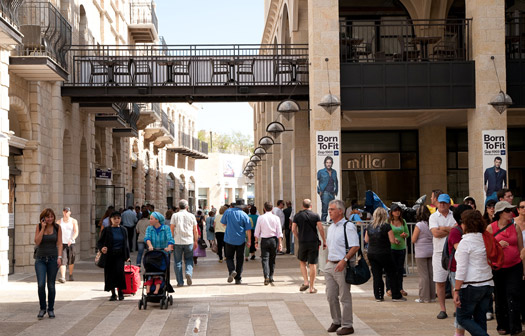
Promenade, Mamilla Center, Jerusalem Israel, 2010. Photo by Ardon Bar Hama
Even though Moshe Safdie made his name in Montreal, as the 26-year-old architect of a model prefabricated housing project called Habitat that became the unexpected star of the Expo ’67 hit parade, the city that has been the most frequent metropolitan object of his musings, teachings, writings and practice over the subsequent decades is Jerusalem.
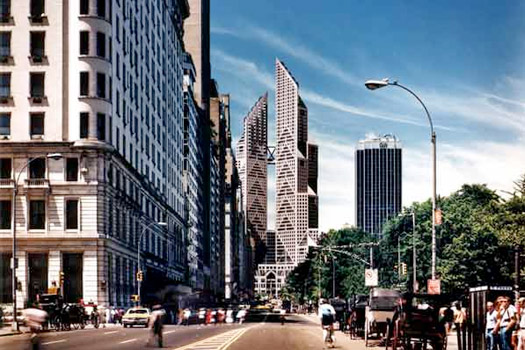
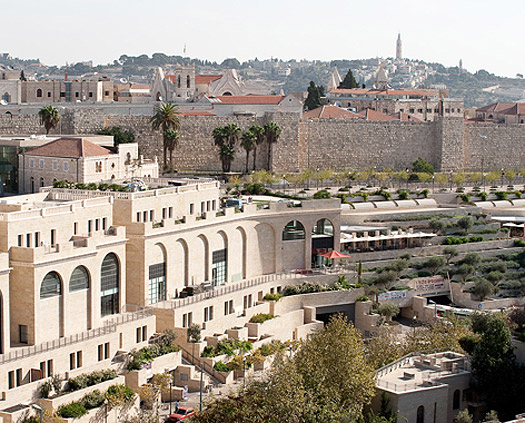
Even though Moshe Safdie made his name in Montreal, as the 26-year-old architect of a model prefabricated housing project called Habitat that became the unexpected star of the Expo ’67 hit parade, the city that has been the most frequent metropolitan object of his musings, teachings, writings and practice over the subsequent decades is Jerusalem.
Safdie was raised in Haifa until, reluctantly, he emigrated with his family to Canada at age fourteen. Since then, Israel has been more or less a constant in Safdie’s ever-widening cone of vision (his current project roster extends from Washington, D.C. to Singapore). The year that Habitat was built was also the year of Israel’s Six Day War against a consortium of Arab states, and when the dust cleared, Safdie stood ready to help, beginning a four-plus-decade-long professional association with his native country in various roles — adviser, master planner, urban designer, architect, landscape architect — serving a roster that includes the Israeli national government, the municipal authorities of Jerusalem, private developers and private clients.
As chair of Harvard University’s Department of Urban Planning and Design in the 1970s and early 1980s, Safdie led a series of interdisciplinary studios culminating in a landmark publication, The Harvard Jerusalem Studio. Over five years, teams of faculty and graduate students collected and analyzed data on Jerusalem’s diverse populations, existing land use and contested areas, infrastructure, projected growth, and thousands of years of history. Conducted in the waxing years of historicist postmodernism, the Harvard Jerusalem studios brought archaeology, sociology, contemporary politics, history, geography and the aesthetics of urban form to bear on what, sadly, remains one of the world’s most fraught urban sites: Jerusalem’s four-thousand-year-old Old City and its surrounding areas.
In the mid-1980s, Safdie’s early catapult to stardom began, perhaps inevitably, to meet the effects of gravity. The weight of his reputation increasingly rested not on Habitat, nor on the laurels of his pedagogically pathbreaking research in The Harvard Jerusalem Studio nor on how his buildings embody and effectuate socially progressive ideals, nor on the incisive insights offered in his many publications, but on the superficially historicist details of form in the projects by him and his students published in The Harvard Jerusalem Studio and in his own new buildings in Israel, Canada and elsewhere. Those arches. Those lightly ornamented moldings. Awkward geometric forms deployed in glass prisms. Historicist postmodernism’s moment of glory was brief and its downfall precipitous. (It’s not only in fashion that one day you’re in, the next, you’re out.)
In the mid-1980s, Safdie’s early catapult to stardom began, perhaps inevitably, to meet the effects of gravity. The weight of his reputation increasingly rested not on Habitat, nor on the laurels of his pedagogically pathbreaking research in The Harvard Jerusalem Studio nor on how his buildings embody and effectuate socially progressive ideals, nor on the incisive insights offered in his many publications, but on the superficially historicist details of form in the projects by him and his students published in The Harvard Jerusalem Studio and in his own new buildings in Israel, Canada and elsewhere. Those arches. Those lightly ornamented moldings. Awkward geometric forms deployed in glass prisms. Historicist postmodernism’s moment of glory was brief and its downfall precipitous. (It’s not only in fashion that one day you’re in, the next, you’re out.)

Columbus Center, 1989. Image from Moshe Safdie and Associates
In 1985 Safdie, who had by then resettled in Cambridge, Massachusetts, teamed up with Boston Properties and Solomon Brothers to propose a 5-million-plus-square-foot mixed-use complex to replace the old New York City Coliseum on Broadway and 59th Street. The project was certainly far too large, but then again developers often, or even usually, initiate a proposal for a major project that includes much more square footage than they realistically expect to wring out of a city’s zoning and public appeals boards. The Columbus Center became the target for an almost unprecedented public outcry, and was killed, but the venom with which it was received was owing to reasons other than its design, which was urbanistically advanced. The Columbus Center project was published with the kind of purplish nighttime views that are standard promotional fare for developers but, for the by-then-thoroughly-academicized American architectural elite, were deemed "Oh! Such Bad Taste!" Safdie’s reputation plummeted. This architect — this man — had bad taste, or perhaps he just had no taste.
Since then, Safdie’s reputation among architectural critics and the so-called avant garde in the academy remains frozen in 1980s time despite his many impressive and publicly admired projects, including civic and academic buildings, museums, airports. In light of the dismayingly plebeian Time Warner Center that stands at Columbus Circle today, Safdie’s condemned Columbus Center project looks very, very good. This alone should be enough to encourage proponents of the built environment — at least, those willing to take public positions that are deeply uncool — to look again. But it has not.
Now Safdie’s nearly completed Mamilla Alrov Center in Jerusalem, the last portion of a 28-acre mixed-use development, more than thirty years in the making, indisputably establishes him as one of today’s very best urban designer-architects. Forget, for a moment, the lightly etched lintels and structural arches of the architecture if you don’t like them — we can talk about style later — Mamilla reveals that the seventy-plus-year-old Safdie, two fingers on the pulse of contemporary culture, continues to be gifted with an unusual mix of cultural savvy, political pragmatism and social progressivism. Here is a complex that ought to become an exemplar for a 21st-century public realm. This erudite, dogged social activist for the built environment is no has-been at all.
In 1985 Safdie, who had by then resettled in Cambridge, Massachusetts, teamed up with Boston Properties and Solomon Brothers to propose a 5-million-plus-square-foot mixed-use complex to replace the old New York City Coliseum on Broadway and 59th Street. The project was certainly far too large, but then again developers often, or even usually, initiate a proposal for a major project that includes much more square footage than they realistically expect to wring out of a city’s zoning and public appeals boards. The Columbus Center became the target for an almost unprecedented public outcry, and was killed, but the venom with which it was received was owing to reasons other than its design, which was urbanistically advanced. The Columbus Center project was published with the kind of purplish nighttime views that are standard promotional fare for developers but, for the by-then-thoroughly-academicized American architectural elite, were deemed "Oh! Such Bad Taste!" Safdie’s reputation plummeted. This architect — this man — had bad taste, or perhaps he just had no taste.
Since then, Safdie’s reputation among architectural critics and the so-called avant garde in the academy remains frozen in 1980s time despite his many impressive and publicly admired projects, including civic and academic buildings, museums, airports. In light of the dismayingly plebeian Time Warner Center that stands at Columbus Circle today, Safdie’s condemned Columbus Center project looks very, very good. This alone should be enough to encourage proponents of the built environment — at least, those willing to take public positions that are deeply uncool — to look again. But it has not.
Now Safdie’s nearly completed Mamilla Alrov Center in Jerusalem, the last portion of a 28-acre mixed-use development, more than thirty years in the making, indisputably establishes him as one of today’s very best urban designer-architects. Forget, for a moment, the lightly etched lintels and structural arches of the architecture if you don’t like them — we can talk about style later — Mamilla reveals that the seventy-plus-year-old Safdie, two fingers on the pulse of contemporary culture, continues to be gifted with an unusual mix of cultural savvy, political pragmatism and social progressivism. Here is a complex that ought to become an exemplar for a 21st-century public realm. This erudite, dogged social activist for the built environment is no has-been at all.

Mamilla Center, Jerusalem Israel, 2010. Photo by Ardon Bar Hama
The Mamilla Center, built in the Hinom Valley, a large, riverine, 28-acre swathe of land in central Jerusalem that traces the former 1967 green line that had plowed through the heart of the city, contains retail, office and residential spaces, an ultra-luxury hotel, and a two-level open-air pedestrian mall walkway culminating in a small multitiered landscaped park adjacent to the Jaffa Gate entrance to the Old City. Most of this is built atop a Safdie-designed 1600-car multistory parking garage and bus terminal, one of the best parking garages I know, with natural light falling from skylights into every level. From every vantage point that matters this transportation facility is nearly invisible: it just looks like landscaped terracing, or a series of progressively diminishing buttresses supporting the adjacent foundation walls of the Old City. Greenery (sustainable, of course) cascades down from planters on each tier.
In judging any urban development, one must consider what it replaced, what it is and what it might have been instead. As to the first and the second: Mamilla is superb. What was formerly a politically contested, no-man's slum land is now a lively, thoroughly contemporary, mixed-use neighborhood where new buildings and spaces lace quietly through meticulously preserved, historically significant buildings to create a variety of vibrant, appealing indoor and outdoor public spaces. From Jerusalem’s politically charged, polycentric, multiethnic, torn and fraying fabric, Safdie has created a fistful of a “public realm” in the classic sense of the term. (Let’s just dismiss out of hand the so-called theoretical positions, both despicable and ridiculous, that maintain the public realm is dead, or can be resuscitated only by the architectural hyperstimulation of shop-o-philiacs.) As high-end jewelry stores cohabit with mid-range eateries, popular (and populated) cafés, a supermarket-style CVS and the Gap, Mamilla invites and is used by people of different classes, ethnicities and political persuasions. On mild-weathered days, black-hatted religious and bare-headed secular Jews, robed Armenian monks, Christian locals, a glut of backpack-toting tourists and a smattering of Palestinians can be seen brushing shoulders, mingling, prospecting, interacting. (More Palestinians would be nice, but even extraordinary urban design isn’t up to solving that one.)
Mamilla offers an object lesson in two related but distinct professional practices and disciplines: architectural urban design and historic preservation (which is a more fraught subject in the United States than elsewhere, at least if one judges by the seemingly nonstop debate sparked by the now-completed adaptive reuse of the Museum of Arts and Design in New York City). As to the latter: when the Israelis won east Jerusalem from the Jordanians in 1967, the Mamilla site contained only one building of indisputable historic and aesthetic significance: the magnificently austere 19th-century French Hospice of Saint Vincent de Paul. Safdie’s office initially bowed to the developer’s disinclination to shoulder the costly prospect of preserving more. But ultimately, his office did the right thing, and recommended the preservation of other valuable but less monumental buildings on the site, including two stretches of small, masonry, arched cave-like spaces and a 19th-century two-story, masonry block residence known as the Stern House where the founder of Zionism, Theodor Herzl, once slept.
The Mamilla Center, built in the Hinom Valley, a large, riverine, 28-acre swathe of land in central Jerusalem that traces the former 1967 green line that had plowed through the heart of the city, contains retail, office and residential spaces, an ultra-luxury hotel, and a two-level open-air pedestrian mall walkway culminating in a small multitiered landscaped park adjacent to the Jaffa Gate entrance to the Old City. Most of this is built atop a Safdie-designed 1600-car multistory parking garage and bus terminal, one of the best parking garages I know, with natural light falling from skylights into every level. From every vantage point that matters this transportation facility is nearly invisible: it just looks like landscaped terracing, or a series of progressively diminishing buttresses supporting the adjacent foundation walls of the Old City. Greenery (sustainable, of course) cascades down from planters on each tier.
In judging any urban development, one must consider what it replaced, what it is and what it might have been instead. As to the first and the second: Mamilla is superb. What was formerly a politically contested, no-man's slum land is now a lively, thoroughly contemporary, mixed-use neighborhood where new buildings and spaces lace quietly through meticulously preserved, historically significant buildings to create a variety of vibrant, appealing indoor and outdoor public spaces. From Jerusalem’s politically charged, polycentric, multiethnic, torn and fraying fabric, Safdie has created a fistful of a “public realm” in the classic sense of the term. (Let’s just dismiss out of hand the so-called theoretical positions, both despicable and ridiculous, that maintain the public realm is dead, or can be resuscitated only by the architectural hyperstimulation of shop-o-philiacs.) As high-end jewelry stores cohabit with mid-range eateries, popular (and populated) cafés, a supermarket-style CVS and the Gap, Mamilla invites and is used by people of different classes, ethnicities and political persuasions. On mild-weathered days, black-hatted religious and bare-headed secular Jews, robed Armenian monks, Christian locals, a glut of backpack-toting tourists and a smattering of Palestinians can be seen brushing shoulders, mingling, prospecting, interacting. (More Palestinians would be nice, but even extraordinary urban design isn’t up to solving that one.)
Mamilla offers an object lesson in two related but distinct professional practices and disciplines: architectural urban design and historic preservation (which is a more fraught subject in the United States than elsewhere, at least if one judges by the seemingly nonstop debate sparked by the now-completed adaptive reuse of the Museum of Arts and Design in New York City). As to the latter: when the Israelis won east Jerusalem from the Jordanians in 1967, the Mamilla site contained only one building of indisputable historic and aesthetic significance: the magnificently austere 19th-century French Hospice of Saint Vincent de Paul. Safdie’s office initially bowed to the developer’s disinclination to shoulder the costly prospect of preserving more. But ultimately, his office did the right thing, and recommended the preservation of other valuable but less monumental buildings on the site, including two stretches of small, masonry, arched cave-like spaces and a 19th-century two-story, masonry block residence known as the Stern House where the founder of Zionism, Theodor Herzl, once slept.
For this wider range of buildings, Safdie’s office developed a variety of preservation strategies — restoration, renovation, adaptive reuse — tailoring their approach to each building's condition and historic value. As a result, this pedestrian mall feels like a mostly not-new place: one masonry bank of arched cells houses funky, small shops offering artisan-made wares: contemporary Judaica tsotchkes, cool clothing, perfumes to serenity. The Stern House and another arcaded bank of shops were reconstructed on their original sites — during construction, these had to be dismantled block by masonry block, each stone numbered, indicating its location, then warehoused until infrastructure construction was complete. Playfully, Safdie’s office decided not to sandblast these many reused masonry blocks clean, so their facades are enlivened with graffiti-like black scribbled numbers, a record of the process of their preservation. Walking around here, one sees a cohesive architectural composition that contains new construction along with old buildings that have been adapted, renovated and restored.
As to style. For new construction on the promenade, Safdie took his cues from the materials, construction and style of the site’s existing buildings. To do otherwise would have called too much attention to the new buildings, and Safdie rightly decided that his new buildings should be this cast’s supporting members, not its stars. This deferential gesture should be admired, not disdained: few internationally recognized designers would resist the temptation to make a bold, signature gesture on this extra-extraordinary site. Mamilla’s new buildings employ a design vocabulary best described as highly abstracted historicism made contemporary. Masonry block is mixed with exposed steel and finished concrete. Heavy, hand-hewn masonry arches are echoed in color and shape by thin, precise concrete arches that stand apart from the rectangular posts that they span. Safdie, deferring to the language and materials of existing buildings and taking advantage of their human scale without aping their details, has quietly added another layer to the complex history of this site, while maintaining that old is old, and new is new.
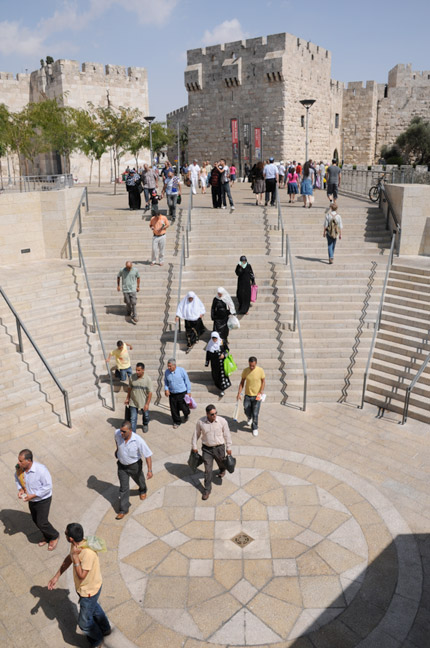
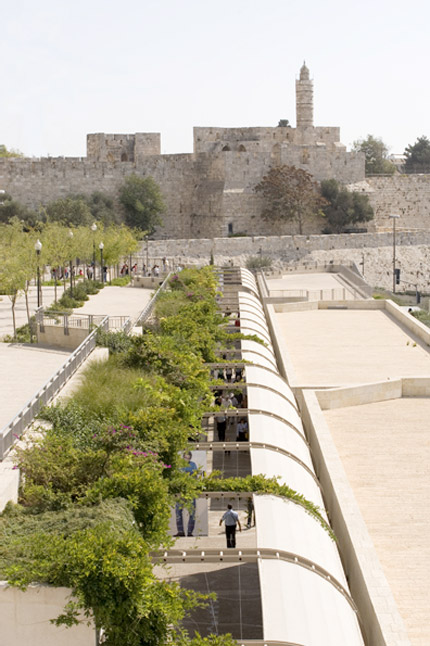
As to style. For new construction on the promenade, Safdie took his cues from the materials, construction and style of the site’s existing buildings. To do otherwise would have called too much attention to the new buildings, and Safdie rightly decided that his new buildings should be this cast’s supporting members, not its stars. This deferential gesture should be admired, not disdained: few internationally recognized designers would resist the temptation to make a bold, signature gesture on this extra-extraordinary site. Mamilla’s new buildings employ a design vocabulary best described as highly abstracted historicism made contemporary. Masonry block is mixed with exposed steel and finished concrete. Heavy, hand-hewn masonry arches are echoed in color and shape by thin, precise concrete arches that stand apart from the rectangular posts that they span. Safdie, deferring to the language and materials of existing buildings and taking advantage of their human scale without aping their details, has quietly added another layer to the complex history of this site, while maintaining that old is old, and new is new.

Mamilla Center, Jerusalem Israel, 2010. Photo by Michal Ronnen Safdie

Promenade, Mamilla Center, Jerusalem Israel, 2010. Photo by Ardon Bar Hama
With regard to the project’s urban design writ large: not every one of Mamilla’s processional and experiential moments equals the quiet dignity of its architecture or the sparkling vibrancy of its pools and eddies of activity. Some of the views as one walks away from the Jaffa Gate toward the busy Shlomo HaMelech Boulevard are mundane — lost opportunities — as is the transparent-domed atrium, the promenade’s principal interior public space and a moment when Safdie could have stretched his wings compositionally while maintaining the design integrity of the whole.
These are minor flaws, however, in comparison to the project’s extraordinary accomplishments. Mamilla towers above comparable recent master planning and urban design projects built in public/private partnerships — City Center in Las Vegas, the new World Trade Center site, Renzo Piano’s Potsdamer Platz in Berlin. It is the rare example in contemporary design in which the “private” in public-private partnerships have not steamrolled over the public good.
Unlike typical pedestrian shopping malls, never do Mamilla’s indoor or outdoor retail areas confer the impression of an artificial world, vacant of all sense of time and place. Walking toward the Jaffa Gate offers changing views of two of the Old City's most prominent monuments, David's Tower and the Citadel of David. The retail blocks lining most of the promenade are low-slung, and Safdie set the commercial towers back from the façade line, and spaced them apart from one another, so that they are nearly unnoticeable and block little sun. Shopping opportunities are interrupted at irregularly spaced intervals by outdoor, semi-enclosed and enclosed public areas. Generously proportioned stairs lead up to Jaffa and down to Yitzhak Kariv streets, and an especially monumental staircase beautifully frames the view of the Hospice. Two small open amphitheaters can be used either for performances or just for sitting down for a chat.
Around the Jaffa Gate, commerce falls away, and the promenade spreads into a multileveled, landscaped urban plaza. Here, next to the walls leading into one of the oldest continually populated cities on earth, you stand in purely public space to look out over the Hinom valley and west Jerusalem. Mamilla should be both celebrated and emulated for its deft interweaving of infrastructure, urban design and architecture; its judicious compositional differentiation of background building from monument; its handling of old and new; and the cosmopolitan vibrancy of its polynodal, multilevel promenade. But this project, surely one of the jewels crowning Safdie’s long career, also should be recognized as an important contribution to contemporary urban design practice because it has made, out of nothing, a public realm that is both cosmopolitan and deeply situated in its place. Mamilla is a worthy successor to modernity's most beloved public spaces — the Galleria in Milan, or Rockefeller Center in New York City. It is a lively place that will, quietly but insistently, remind all who will use it of the specificity and identity of this extraordinary place.
These are minor flaws, however, in comparison to the project’s extraordinary accomplishments. Mamilla towers above comparable recent master planning and urban design projects built in public/private partnerships — City Center in Las Vegas, the new World Trade Center site, Renzo Piano’s Potsdamer Platz in Berlin. It is the rare example in contemporary design in which the “private” in public-private partnerships have not steamrolled over the public good.
Unlike typical pedestrian shopping malls, never do Mamilla’s indoor or outdoor retail areas confer the impression of an artificial world, vacant of all sense of time and place. Walking toward the Jaffa Gate offers changing views of two of the Old City's most prominent monuments, David's Tower and the Citadel of David. The retail blocks lining most of the promenade are low-slung, and Safdie set the commercial towers back from the façade line, and spaced them apart from one another, so that they are nearly unnoticeable and block little sun. Shopping opportunities are interrupted at irregularly spaced intervals by outdoor, semi-enclosed and enclosed public areas. Generously proportioned stairs lead up to Jaffa and down to Yitzhak Kariv streets, and an especially monumental staircase beautifully frames the view of the Hospice. Two small open amphitheaters can be used either for performances or just for sitting down for a chat.
Around the Jaffa Gate, commerce falls away, and the promenade spreads into a multileveled, landscaped urban plaza. Here, next to the walls leading into one of the oldest continually populated cities on earth, you stand in purely public space to look out over the Hinom valley and west Jerusalem. Mamilla should be both celebrated and emulated for its deft interweaving of infrastructure, urban design and architecture; its judicious compositional differentiation of background building from monument; its handling of old and new; and the cosmopolitan vibrancy of its polynodal, multilevel promenade. But this project, surely one of the jewels crowning Safdie’s long career, also should be recognized as an important contribution to contemporary urban design practice because it has made, out of nothing, a public realm that is both cosmopolitan and deeply situated in its place. Mamilla is a worthy successor to modernity's most beloved public spaces — the Galleria in Milan, or Rockefeller Center in New York City. It is a lively place that will, quietly but insistently, remind all who will use it of the specificity and identity of this extraordinary place.
